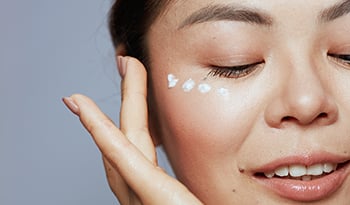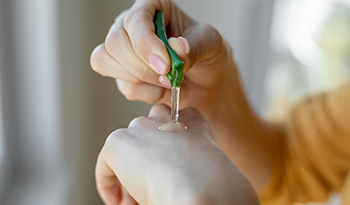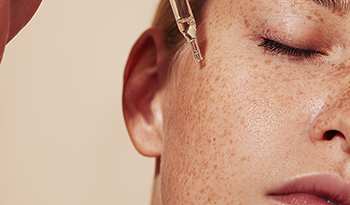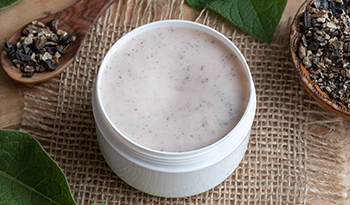Beta-Glucan: A Buzzworthy Skincare Ingredient

If you’re tuned into the skincare world, you may have heard about the popular ingredient beta-glucan (B-glucan). In this article, I’ll break down what it is, why it’s used in skincare products, and which products to look out for.
What Are Beta-Glucans?
Beta-glucans are polysaccharides, which means they are molecules made up of multiple sugar building blocks. In nature, polysaccharides are generally considered to be structural and storage molecules. For example, in plants, sugars are stored as the polysaccharide called “starch,” whereas in humans, sugars are stored as the polysaccharide called “glycogen.” In plants, fungi, and arthropods, polysaccharides such as cellulose or chitin make up the structure of the cell walls or exoskeletons.
Beta-glucans refer to specific types of polysaccharides that can be found in cereals (like oats, barley, and other grains), fungi, yeasts, and seaweed, among other things. When we eat plants and grains that contain beta-glucans, they are a source of dietary fiber.
When taken orally, beta-glucans have shown some evidence that they can help lower cholesterol, which may help reduce the risk of heart disease. There are a number of other possible reported benefits for oral beta-glucans, but the science to fully support those claims is still not very strong.
How Do Beta-Glucans Affect The Skin?
In the world of cosmetics and skincare, beta-glucans have attracted a lot of interest due to their properties in improving skin health.
Beta-Glucans and Skin Hydration
Perhaps the most well-known feature of beta-glucans is their role in skin moisturization. For example, there was a 6-week randomized, double-blind, placebo-controlled study on 13 people with sensitive skin who applied a beta-glucan formulation twice a day. The researchers concluded that the skin’s ability to retain moisture was increased, and the loss of water from the skin (transepidermal water loss) was decreased in the people who used the beta-glucan application, leading to overall improved skin hydration. In addition, there also was a 16-week randomized, double-blind, placebo-controlled study of 20 men in which the beta-glucan formulation was applied twice daily and lead to significant improvement in skin roughness and hydration. One recent study even looked at a beta-glucan formulation that was applied to one side of the face after cosmetic laser treatment in 20 patients. In that study, the side that was treated with the beta-glucan product was better hydrated, with lower levels of transepidermal water loss.
These research findings suggest a role for beta-glucans in maintaining skin hydration, and because of their ability to help hydrate the skin, beta-glucans may minimize the appearance of fine lines and wrinkles. This is because when the skin is well-hydrated, the skin is more plump and healthy, making wrinkles a little less noticeable. Who wouldn’t want that?!
Beta-Glucans and Skin Conditions
Because of the hydration and immune-boosting capabilities of beta-glucans in skincare products, beta-glucans have also been researched in people with sensitive, dry skin conditions such as atopic dermatitis. For example, in one study of 80 people with atopic dermatitis, a beta-glucan formulation was applied to one side of the body, and that side had fewer skin “flares.” Another study on rats with atopic dermatitis tested an oral beta-glucan product combined with a probiotic. The researchers found lower levels of itch and inflammation in the rats who received the beta-glucan formulation.
As a dermatologist, I would probably want to see more evidence that beta-glucan works for atopic dermatitis before I could start regularly recommending it as part of a treatment plan, but it definitely seems like there could be some possible benefit, and it is worth learning more about. One of the main things I would caution about regarding the use of topical beta-glucans for people who have sensitive skin or atopic dermatitis is that a lot of the commercial skincare products with beta-glucan also contain a number of other preservatives, fragrances, and botanical ingredients, which can sometimes cause irritation and allergies, especially in people who are prone to such reactions.
In addition to their role in skin hydration, there are also a number of studies that have shown beta-glucans to be beneficial in speeding up wound healing. Although beta glucan isn’t routinely used as a standard wound care treatment in the medical profession, it has been demonstrated to have beneficial effects on wound healing not only in the lab but also in mice, rats, fish, and humans! Maybe we will see more of it as a part of wound care in the years to come.
How To Incorporate Beta-Glucan Into Your Skincare Routine
Now that you’ve learned what the beta-glucan ingredient is and the potential benefits for the skin, you may be interested in incorporating beta-glucan into your skincare routine. But how?
To create a dermatologist-approved skincare routine, I always say that three main components should be included as part of a solid foundation for a skincare regimen: 1) A gentle cleanser, 2) Sunscreen with at least SPF 30 or higher, and 3) Moisturization and skin barrier support.
Beta-glucan as an ingredient falls into the moisturization step of the skincare routine, so I would look for it in products that are marketed as “hydrating” or “moisturizing.” The moisturizing step usually comes at the end of the skincare routine and is most effective when applied to damp skin, morning and night.
DISCLAIMER:This Wellness Hub does not intend to provide diagnosis...













































































 Table of Contents
Table of Contents















